This post may seem a little redundant to regular viewers because just 5 days ago I covered this same subject. But as luck would have it, yesterday at Farmington I photographed another Pied-billed Grebe as it used this interesting “diving” technique and these images have better light and detail and a different angle on the bird so I decided to run with it once again.
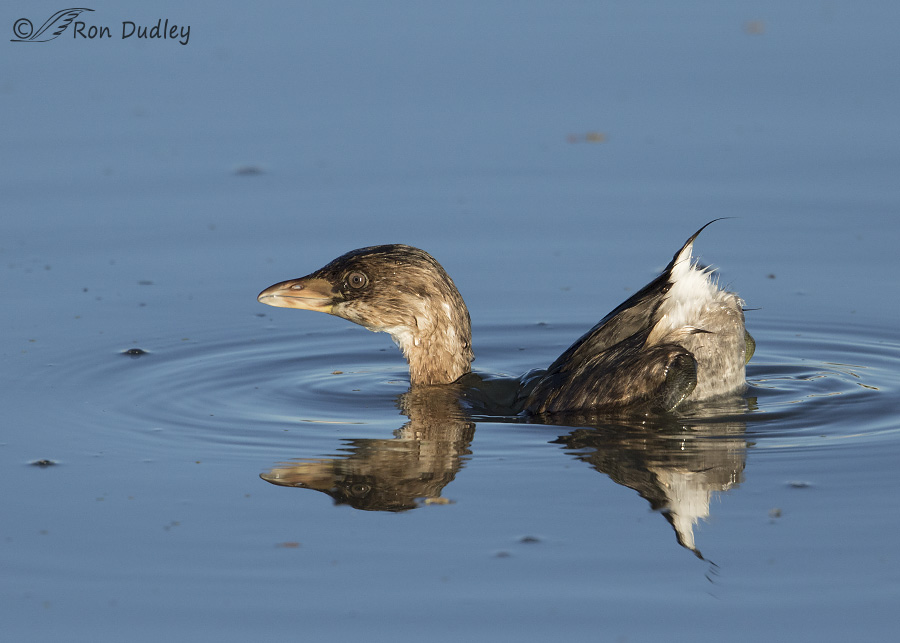
1/3200, f/6.3, ISO 800, Canon 7D Mark II, Canon EF 500mm f/4L IS II USM + 1.4 tc, not baited, set up or called in
By the time I was able to acquire focus on the bird it had already begun to sink. When they do this they’re usually spooked by something and at first I didn’t know what it was but…
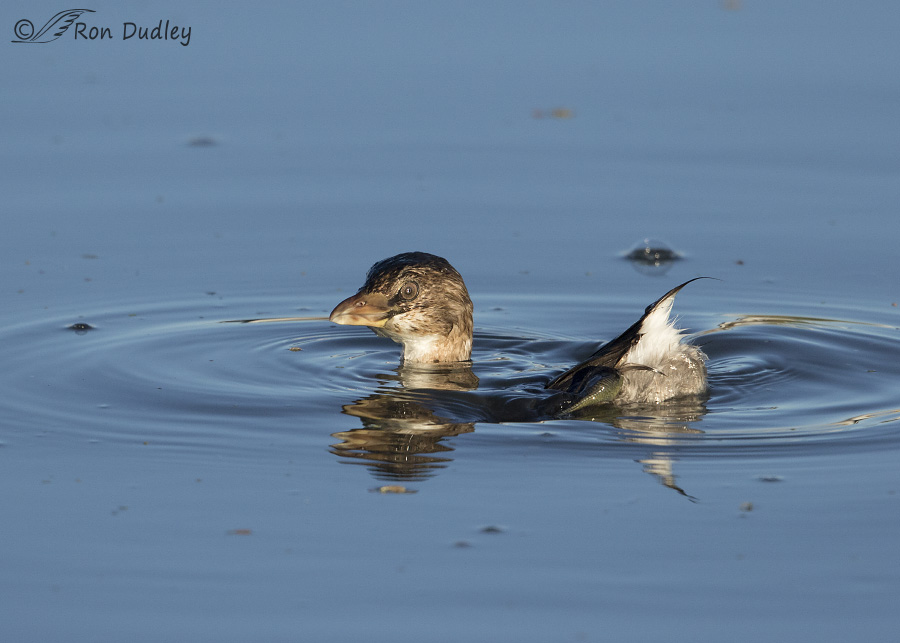
1/3200, f/6.3, ISO 800, Canon 7D Mark II, Canon EF 500mm f/4L IS II USM + 1.4 tc, not baited, set up or called in
it soon became apparent that it’s attention was focused on my pickup so I believe it was me that made it nervous.

1/3200, f/6.3, ISO 800, Canon 7D Mark II, Canon EF 500mm f/4L IS II USM + 1.4 tc, not baited, set up or called in
It held that vertical position for a moment as it watched me but soon…
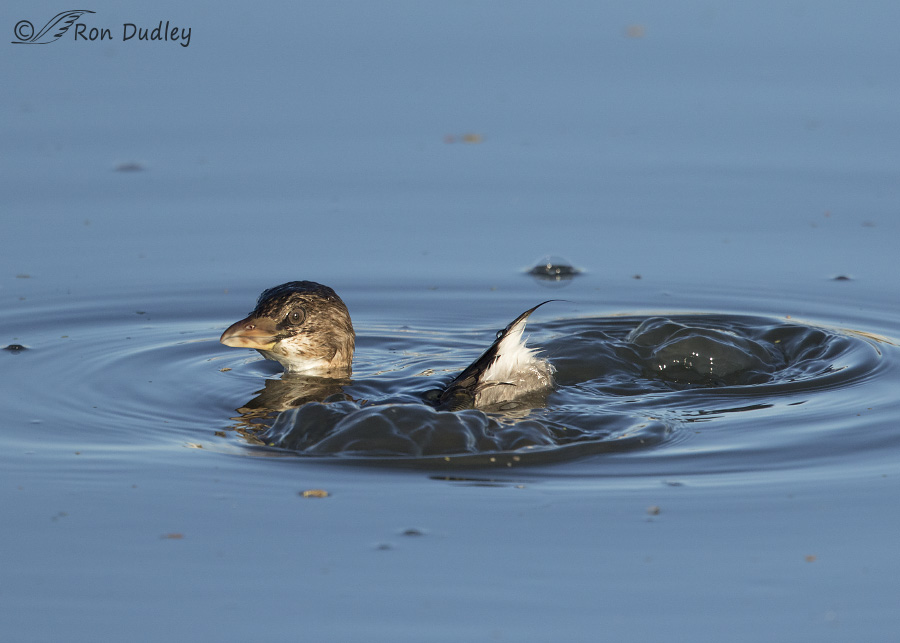
1/2500, f/6.3, ISO 800, Canon 7D Mark II, Canon EF 500mm f/4L IS II USM + 1.4 tc, not baited, set up or called in
it once again began to sink. From the water turbulence on the sides of the bird we can see that it’s now using its incredibly flexible legs and feet to propel itself straight down.
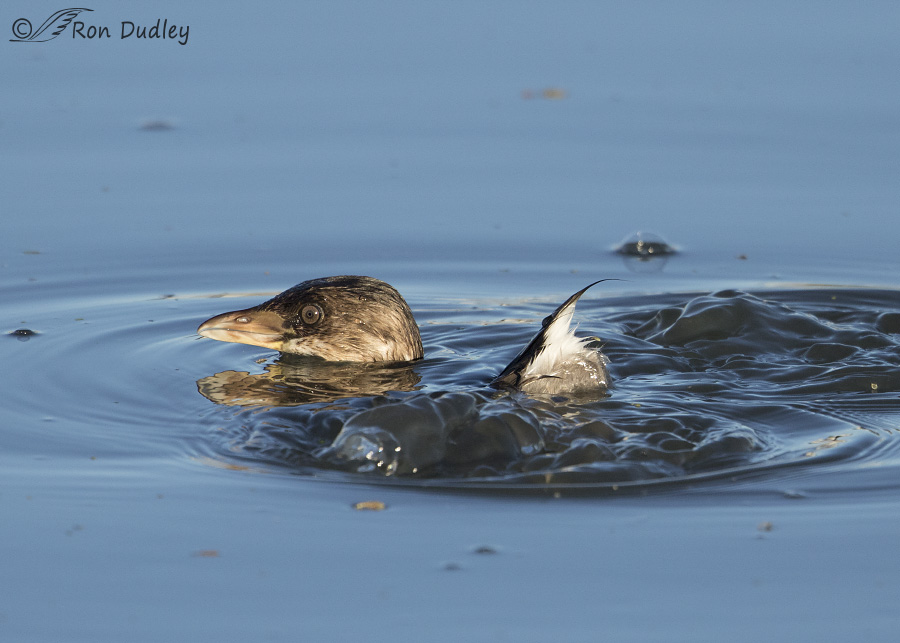
1/2500, f/6.3, ISO 800, Canon 7D Mark II, Canon EF 500mm f/4L IS II USM + 1.4 tc, not baited, set up or called in
In my experience they always turn their heads forward again just before their head goes under the surface (a minor observation but it’s something I’ve noticed).
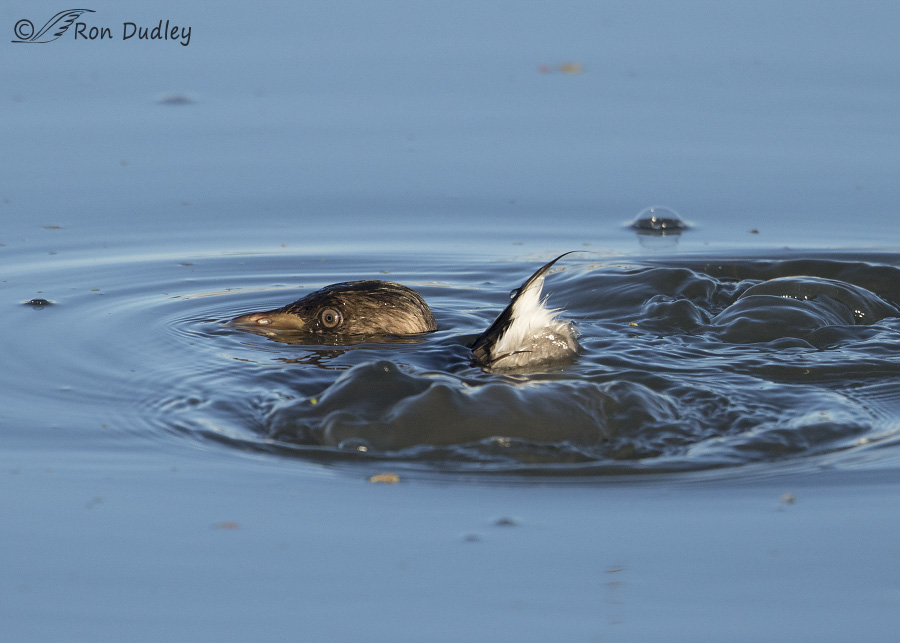
1/2500, f/6.3, ISO 800, Canon 7D Mark II, Canon EF 500mm f/4L IS II USM + 1.4 tc, not baited, set up or called in
Close observation of the water ripples around the head show that there is absolutely no forward momentum during this process. The bird is sinking straight down.
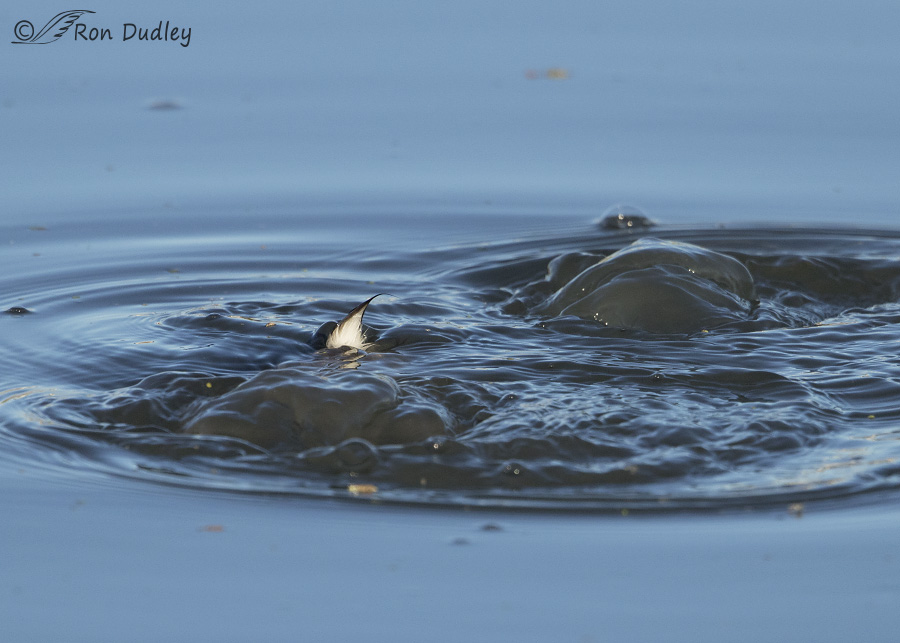
1/2500, f/6.3, ISO 800, Canon 7D Mark II, Canon EF 500mm f/4L IS II USM + 1.4 tc, not baited, set up or called in
As always the last body part to disappear is the tail…
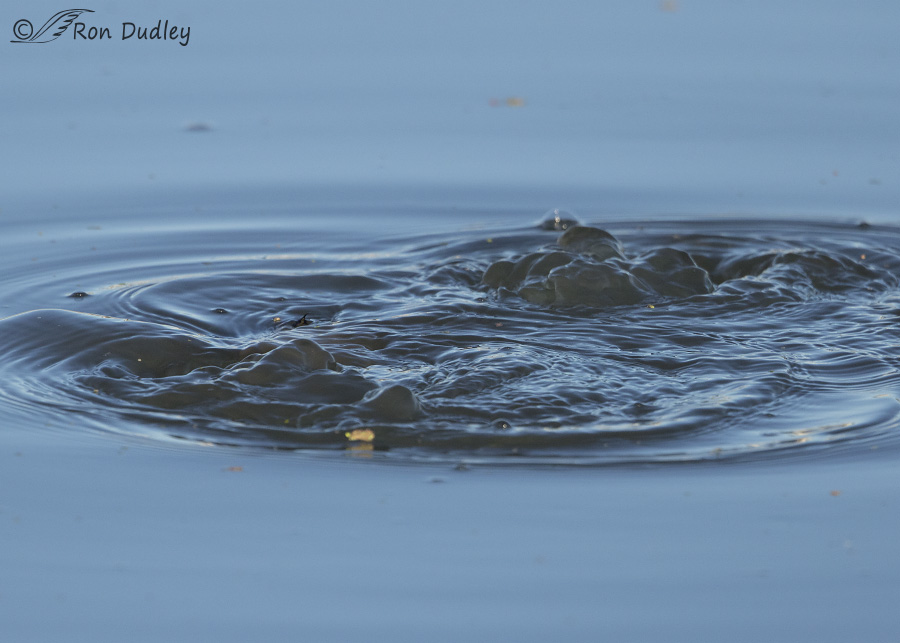
1/2500, f/6.3, ISO 800, Canon 7D Mark II, Canon EF 500mm f/4L IS II USM + 1.4 tc, not baited, set up or called in
leaving behind only turbulence at the surface.
This diving technique is called “gradual sinking”, one of several used by Pied-billed Grebes. I’ve never seen Western or Clark’s Grebes use the technique and I’m unaware whether or not other grebe species use it.
On another unrelated note some of my recent posts have been partially about the relatively large size of fish that some of these grebes tackle.
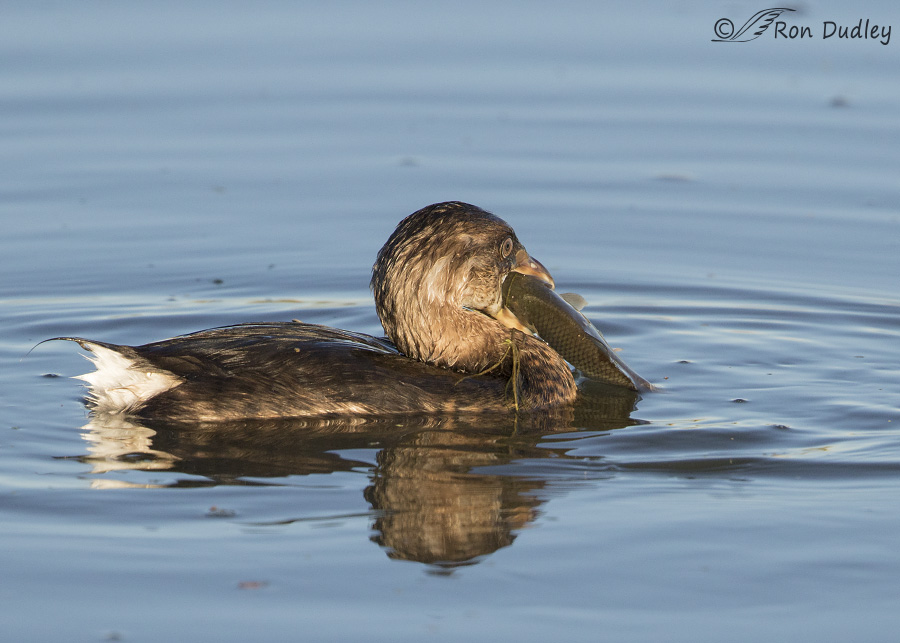
1/2500, f/6.3, ISO 640, Canon 7D Mark II, Canon EF 500mm f/4L IS II USM + 1.4 tc, not baited, set up or called in
Shortly before this diving series was photographed I also found this grebe lugging around a huge fish (for the size of the bird). I was pretty excited about the opportunity to photograph the struggle as this small grebe tried to swallow such large prey but after about 3 seconds with the bird another photographer drove by and spooked the bird so it dove with the fish and I never saw it again that I know of.
Damned photographers! 🙂
Ron


Very interesting Ron ! I love the way you captured the water dynamics. Beautiful.
Thanks very much, Ed.
Patty’s story (and I like you and probably everyone who comments here I have seen similar acts of selfish bastardry) reminds me that we don’t devote NEARLY enough research money to finding a cure for jerks.
Loved the gradual sinking. You can post photos of it just as often as you come across them. Which given that they are not owls and don’t have britches (on display) says a lot about how intriguing I find the behaviour. Thank you. As always.
“a cure for jerks”
Now that would be something that would really improve humanity, wouldn’t it, EC? Birds, wildlife and the rest of the natural world would also benefit. Immensely.
Thanks for posting this second sequence; as you mentioned there is better light this time. How long does it take from the beginning to the end of the dive? Is this dive technique used only for escape? This brings up another question; can you recommend a reference book that is more than just for identification? I would like to know more than just the name of what I’m looking at, but some of the behaviors too. Everyone has experienced the problem of another photographer getting in the way. I am amazed how many people walk in front of a landscape photographer, using a tripod, and don’t realize/care that they are ruining it for someone else. I did read that this is the reason Photoshop was developed, to “shop” people out of their photos. PS can’t help what you described. I call those times “neurochromes”, only in your memory bank.
“How long does it take from the beginning to the end of the dive?”
That varies, Chris. It can be quick or slow depending on whether or not they use their feet for a “power dive” or just sink after emptying their air sacs and flattening their feathers to get rid of air trapped between them. I’d estimate that fast dives take less than half a second.
“Is this dive technique used only for escape?”
I believe so, though obviously they could use it at any time. They don’t seem to use it when they’re diving for fish and I suspect the reason for that is that they need as much air supply as possible when they’re after a fish so they don’t want to empty their air sacs before going down.
“can you recommend a reference book that is more than just for identification?”
Typically I don’t use a book when I want detailed info on bird behaviors and natural history. I use “Birds of North America Online” out of Cornell University. I’m a huge fan of theirs despite my implied criticism of them in my answer to Jo Ann’s comment below.
BNA is a paid site but for anyone interested in lots of accurate info on birds it can’t be beat, IMO. It’s a great deal for what you get. I use it constantly – they make me look much smarter than I really am…
Not true…you get smart, then are smart, when you go to them to get answers…which you(now smarter than before) pass on! So there, Smarty!
Wonderful series, Ron and I don’t mind seeing the same behavior again since it is so interesting. I do have a question for you. Do you share you photos with your observations of birds with Cornell or Audubon?? I would think they would want info on wildlife from people out in the birds territory on a regular basis. Especially when it seems to be unpublished behaviors. Just curious because I’ve learned by watching of multiple eagle nests with live cams, they are documenting behaviors that were never observed before yet are seen at multiple nests now over a period of years.
“Do you share you photos with your observations of birds with Cornell or Audubon??”
Jo Ann, I have in the past but don’t anymore – here’s why.
About four years ago I photographed a Western Kingbird casting a pellet. When I looked the behavior up on Cornell’s “Birds of North America Online” it said that they had “no information” (which means that the behavior is undocumented as far as they know) on pellet casting in the species. So I contacted them, sent them a link to my blog post that included the photo and described what I observed. They sounded very interested and asked me if they could use the photo on BNA. I said of course and sent them a copy.
Here’s a link to the post that includes that photo:https://www.featheredphotography.com/blog/2012/03/26/western-kingbirds/
But to this day their account on Western Kingbirds casting pellets still reads “no information”. For that reason I no longer go to the trouble to contact them when I document interesting, unusual or unknown behaviors.
Ron, I can’t believe it?!! What is wrong with them??!! I would think they would be thrilled to get documented, unknown behaviors!! Well that settles it – you need to write your own book on all the bird behaviors you’ve seen and photographed so that the bird lovers/watchers, etc. have that info!! I know when I first got bitten by Bald eagle fever, I started checking out books from the library so I could learn all I could about their behaviors. What I found was that many of the “bibles” on eagles hadn’t been updated in quite a while and the newer books that gave me more current info were photographer books like Kate Davis’s “Bald Eagle Nest: A Story of Survival in Photos”. So see – in your spare time, you need to write your book with all your gorgeous photos documenting bird behavior in the “real” world!!
I don’t care that you posted another series of this behavior just a few days ago. These photos are wonderful. And I hear you about ‘damned photographers’. One of my pet peeves when I’m out watching animals at Hueco Tanks is people who can see a group of us stopped for something, but just walk by talking, never considering that they might be disturbing whatever is going on in the area. Hopefully you’ll get to see what they do with those big fish very soon.
“Hopefully you’ll get to see what they do with those big fish very soon.”
I had a chance to see that this morning, Susan but the grebe swam into the reeds where I couldn’t see what happened to the fish. Later it came out again and still had the fish. I think they’re pretty reluctant to give up on those extra-large fish.
“I’ve certainly uttered that expletive more than once, while trying to quietly observe something, only to have some thoughtless jackass arrive on the scene with his or her “point and shoot” and stand between me and what I was watching, or scare it off…this includes an eagle perched in a nearby tree which I was observing with my grandson, his first sighting of one. The photojerk, drove up, got out, started yelling and waving his arms, because he wanted to get a photo of it flying, scared the eagle into flight, snapped his effing picture and drove off…I was too angry, stunned, and surprised to get his plate number, and turn him in for harassing the the bird…strictly illegal! These shots of the sinking grebe capture a fascinating behaviour. Until I saw your photos and read your comments, I had no idea they did did this!
When I say “observing”, sometimes I was just looking when a photojerk showed up, but most often, I was trying to get a shot myself and they mindlessly, rudely spoiled it, one way other the other…even though it had to be obvious because I had a camera and was trying to focus on a shot…it was as though I was invisible! Once I was trying to photograph a quite “tame” white-tail, when a photojerk showed up, stood right in front of me as if I wasn’t even there, and started throwing McDonald’s french fries at the deer! Real “health food”! This was along the South Shore Road in Old Forge, NY in the Adirondacks. Shortly after that, you weren’t allowed to even stop to photograph them…Or just watch.
Thanks for posting this second series of “the Incredible Sinking Bird”. Both series were excellent, but this was even better than the first. Well worth a revisit….
Thanks, Patty. And I don’t blame you for being upset with the situation when you were watching the eagle, especially since it was the first sighting your grandson had of an eagle.
Some people can be extremely rude. I’ve had folks deliberately honk to scare my bird away as they passed in their vehicle. They knew exactly what I was doing – that huge lens poking out the window is a dead giveaway.
Cool sequence, Ron. It is an interesting tool they have in their box to keep safe. 🙂 The large fish is amazing – always something to interrupt ones plans. 🙂 I’m sure “Damned photographers!” has been uttered by more than one person in more than one circumstance! 🙂
I’m sure you’re right about the utterance, Judy. As in all groups some photographers are considerate and respectful of both their subjects and other photographers while others are simply jerks.
This particular photographer did nothing wrong or inconsiderate. It was just bad timing – comes with the territory.
That it was unintentional was apparent by the way you described it – frustrating still.:)
Yup!
There are gentleman and gentlewoman photographers and slob photographers(what I call “photojerks”)…most of the time I’ve experienced the former, but occassionally, the latter, especially when travelling in high density tourist areas in the West and Midwest…they can be rude, thoughtless, stupid and even dangerous…to themselves and others.